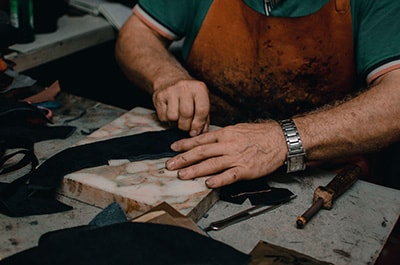Primitive people who lived during the Ice Age some 500,000 years ago were likely the first to use the skins of animals to protect their bodies from the elements. Just as leather today is a byproduct, our ancient ancestors hunted animals primarily for food, but once they had eaten the meat, they would clean the skin by scraping off the flesh and then sling it over their shoulders as a crude form of coat. They also made footwear to protect their bare feet from rocks and thorns by taking smaller pieces of animal skin made to fit loosely over the foot and tied at the ankle with thin strips of skin or even vines. The main problem that primitive man encountered was that after a relatively short time the skins decayed and rotted away. With his limited knowledge and experience, primitive man had no idea how to preserve these hides.
As centuries passed it was noticed that several things could slow down the decay of leather. If the skins were stretched out and allowed to dry in the sun, it made them stiff and hard but they lasted much longer. Various oily substances were then rubbed into the skins to soften them. As time passed, it was eventually discovered that the bark of certain trees contained “tannin” or tannic acid could be used to convert raw skins into what we recognize today as leather. It is quite hard to substantiate chronologically at exactly what time this tanning method materialized, but the famous “Iceman” dating from at least 5,000 BC discovered in the Italian Alps several years ago, was clothed in very durable leather.
Somewhat later, techniques used by Native Americans are very similar to those used in this early period. These Indians took the ashes from their campfires, put water on them and soaked the skins in this solution. In a few weeks the hair and bits of flesh came off, leaving only the raw hide. This tanning method, which used a solution of hemlock and oak bark, took about three months to complete. Then the leather was worked by hand to make the hide soft and pliable.
The Making of Leather Products
The tanning of leather was used by mankind in numerous geographical areas throughout the early periods of human civilization. As certain leather characteristics began to emerge, men realized leather could be used for many purposes besides footwear and clothing. The uses and importance of leather increased greatly. For example, it was discovered that water would keep fresh and cool in a leather bag. It was also found suitable for such other items as tents, beds, rugs, carpet, armor and harnesses.
Ancient Egypt, one of the most developed civilizations in this early period, valued leather as an important item of trade. The Egyptians made leather sandals, belts, bags, shields, harness, cushions and chair seats from tanned skins. Many of these items are in fact still made from leather today.
Similarly, the Greeks and Romans used leather to make many different styles of sandals, boots and shoes. When the Roman legions marched in conquest across Europe, they were well attired in leather armor and leather capes. In fact, right up until the early 18th century, the shield carried by the ordinary soldier was more likely to be made of leather than metal.
The ancient Greeks refer to eight basic guilds of artisans, which included both shoemakers and tanners. Although tanning was originally a cottage trade, the Greeks had full-time professional tanners who were at first employed in leather processing establishments and became independent some time later. The bark of conifer and alder was used as a tannin source and so were the peel of the pomegranate, sumac leaves, walnut, cups of acorns as well as an Egyptian heritage – mimosa bark. The Greeks were also familiar with alum tanning and it appears they knew something about tanning with fish oil.
The types of leathers used were as diversified as the end users. Homer refers to the use of cowhide, goat and weasel leather by the Greeks. The edict issued by the Roman emperor Diocletian which fixed ceiling prices for all kinds of goods and services included skins and leather prepared from goats, sheep, lambs, hyenas, deer, wild sheep, wolves, martens, beaver, bears, jackals, seals, leopards and lions. Under the edict, cowhide was even classified according to groups and qualities. A complete tannery in the famous ash-preserved ruins of Pompeii was unearthed in 1873.




